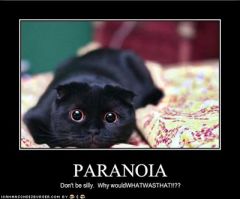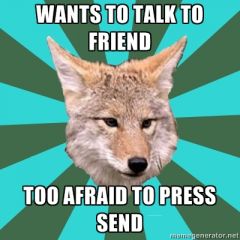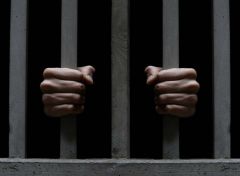![]()
![]()
![]()
Use LEFT and RIGHT arrow keys to navigate between flashcards;
Use UP and DOWN arrow keys to flip the card;
H to show hint;
A reads text to speech;
15 Cards in this Set
- Front
- Back

Categories of Personality Disorders pg. 376
|
Cluster A: Paranoid, schizoid, schziotypal
personality disorders- people with these disorders often seem odd or eccentric, with unusual behavior ranging from distrust & suspiciousness to social detachment. Cluster B: Histrionic, narcissistic, anti-social, borderline personality disorders. Individuals with these disorders have a tendency to be dramatic, emotional, erratic. Cluster C: avoidant, dependent, OCD-- in contrast to the other two clusters, anxiety & fearfulness are often part of these disorders |
|

Paranoid Personality Disorder pg. 376/377
|
*Have persuasive suspiciousness & Distrust of others, leading to numerous interpersonal difficulties
* Tend to see themselves as blameless & blame others for their own mistakes/failures *Chronically "on guard" -- constantly expecting trickery & looking for clues to validate *Preoccupied with doubts about the loyalty of friends *Bear grudges-- refuse to forgive perceived insults & slights, quick to react with anger. |
|

Schizoid Personality Disorder Pg. 377
|
-Unable to form social relationships & lack interest in same.
-Do not have good friends- possible exception of a close relative. -Unable to express feelings & are seen as cold/ distant - Lack social skills- classified as loners or introverts - Tend to not take pleasure in sexual activity & rarely ever marry - Not very emotionally reactive -Apathetic mood |
|

Schizotypal Personality Disorder Pg. 379
|
* excessively introverted & have pervasive social & interpersonal deficits but in addition they have cognitive & perceptual distortions & eccentricities in their communication and behavior.
|
|

Histrionic Personality Disorder Pg. 380
|
*excessive attention- seeking behavior & emotionally
*They tend to feel unappreciated if not center of attention * Their lively, dramatic, excessively extroverted styles often ensure that they can charm others *appearance & behavior are theatrical &emotionally sexually provocative & seductive. *They may try to control their partner through seductive behavior/ emotional manipulation but also show dependence. |
|

Narcissistic Personality Disorder Pg. 382
|
-Show exaggerated sense of self- importance
- A preoccupation with being admired - Lack of empathy for the feelings of others -Grandiosity= most widely used diagnostic criteria -Grandiosity is manifested by a strong tendency to overestimate their abilities & accomplishments, while underestimating the abilities & accomplishments of others. -They behave in stereotypical ways -- constant self- references&Bragging to gain the acclaim & recognition they crave. - They believe they are so special that they only think they can be understood by other high status people or should associate only with such people. they are often unwilling to forgive others for perceived slights, and they easily take offense. ** Have a very fragile and unstable sense of self esteem underneath all their grandiosity. -- This is probably why they are so preoccupied with what others think and why they are so preoccupied with fantasies of outstanding achievement.** |
|

Antisocial Personality Disorder (ASPD) pg. 384
|
Continually violate & show disregard for the rights of others through deceitful, aggressive, or antisocial behavior -- without remorse or loyalty.
- Impulsive, irritable, aggressive & show a pattern of generally irresponsible Behavior. -Must have been occurring since 15 yrs or before the person must have had symptoms of conduct disorder, a similar disorder occurring in youth whom show persistent patterns of aggression toward people/ animals/ destruction of property, deceitfulness or theft, serious violation of rules at home or school. |
|

Borderline Personality Disorder (BPD)
Pg. 385 |
-Show a pattern of behavior characterized by impulsive & instability in interpersonal relationships, self- image, & moods.
- History of intense but stormy relationships, typically involving over idealizations of friends or lovers that later end in bitter disillusionment & disappointment. -Make desperate efforts to avoid real or imagined abandonment- fear of this is so intense. - Mood / affect is highly unstable = drastic mood shifts Affective instability& intense anger - gambling sprees/ reckless driving -suicide attempts, often flagrantly manipulative. Self- mutilation (such as repetitive cutting behavior) is another characteristic feature of borderline personality. In some cases the self- injurious behavior is associated with relief from anxiety or dysphoria. |
|

Avoidant Personality Disorder Pg. 388
|
Show extreme social inhibition & introversion leading to life- long patterns of limited social relationships & reluctant to enter into social interactions
- Because of hypersensitivity to, and their fear of criticism & rebuff -- they do not seek out other people, they desire affection, & are often lonely & bored -They do not enjoy their loneliness, often have feelings of being inept & socially inadequate ( these are the two most prevalent & stable features.) |
|

Dependent Personality Disorder pg. 390
|
-Show an extreme need to be taken care of-- which leads to clinging & submissive behavior.
-Show acute fear at the possibility of separation or just being alone.-- because they see themselves inept. - They usually build their lives around other people & subordinate their own needs & views to keep these people involved with them. -Fail to get appropriately angry -Often involved in psychologically &physically abusive relationships -Have trouble making simple everyday decisions - Significant lack of self confidence & feel helpless. - Occurs in 2 to 4 percent of the population and is more common in women than men |
|

Obsessive- Compulsive Personality Disorder (OCPD) pg. 391
|
-Perfectionism & an excessive concern with maintaining order & control
-Their preoccupation with maintaining mental & interpersonal control occurs in part through careful attention to rules, order, schedules. -They may be devoted to work to the exclusion of leisure activities & may have difficulty relzing or doung anything just for fun. -Rigidity, stubbornness, reluctant to delegate tasks, are the most prevalent/ stable features of OCPD. * it is important to note that people with OCPD do not have true obsessions or compulsion rituals. |
|

Passive- Aggressive Personality Disorder (a.k.a Negativistic Personality disorder) Pg. 392
|
- They show a pervasive pattern of passive resistance to demands in social or work situations, sometimes being highly critical or scornful of authority.
- Strong pattern of negativistic attitudes unrelated to any concurrent depression. - Their passive Resistance to demands is shown in many ways-- from simple resistance to fulfilling routine tasks to being sullen or argumentative, or to alternating between defiance & submission -They commonly complain about personal misfortunes or being misunderstood & unappreciated. |
|

Depressive Personality Disorder Pg. 392
|
- Show a pattern of depressive cognition's & behavior that is pervasive in nature.
- Their usual mood stated is one of unhappiness, gloom, or dejection ( although not necessarily sadness). -They tend to feel inadequate, worthless, remorseful, or guilty. -tend to be pessimistic & prone to worry. - The focus of this diagnosis is more on distorted cognition's & interpersonal traits. |
|

Anti- Social Personality Disorder & Psychopathy (ASPD) pg. 395
|
- The most outstanding characteristic is their tendency to persistently disregard & violate the rights of others.
-They do this through a combination of deceitful, aggressive, and anti-social behaviors. -They have a lifelong pattern of un-socialized & irresponsible behavior with little regard for safety (either their own or others) - These characteristics bring them into repeated conflict with society & highly likely to be incarcerated -Only people 18 & over are diagnosed. |
|
|
Two Dimensions of Psychopathy pg. 396
|
The first dimension involves the affective and interpersonal core of the disorder and reflects traits such as lack of remorse or guilt, callousness's/ lack of empathy, glibness/ superficial charm, grandiose sense of self- worth, and pathological lying.
The second dimension reflects behavior-- the aspects of psychopathy that involve an anti-social, impulsive, and socially deviant lifestyle such as the need for stimulation, poor behavior controls, irresponsibility, and parasitic lifestyle. |

